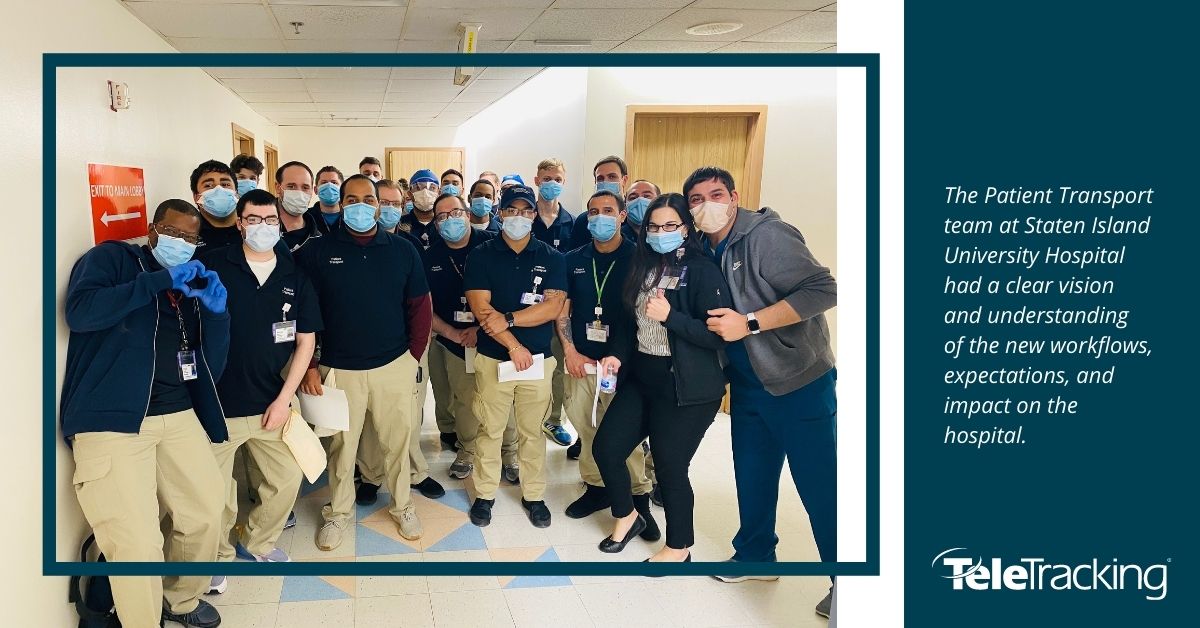Systemwide Visibility at Northwell Health
Oliver Perez is the Director of Support Services at North Shore University Hospital, where he oversees a 225-person environmental services (EVS) team that turns over more than 4,500 beds a month and ensures the complete disinfection of the building. He also leads a 110-member patient transport team which typically handles over 1,000 requests each day. As COVID-19 unfolded, and the cleaning and sanitization procedures became increasingly complex, staff from other areas of the hospital offered their help thus increasing the team by an additional 50 people.
“The safety of every team member and every patient was our first priority. Every level of management wanted to be sure the team felt comfortable and secure. We worked with the nursing educators to train EVS staff on how to don and doff PPE,” says Oliver. “The entire building also started using N95 masks, so we had an in-service training on how to use them—within a week and half, all employees were fitted with the proper version. In addition, we gave them face shields, glasses and disposable scrubs. A lot of thought went into the plans and it involved rapid change. We now have the processes in place to be more prepared if a second wave hits.”
Typically, EVS staff are staged on units. However, as units were converted to COVID units, staff stationed in those areas were trained on new cleaning and sanitization processes with managers showing them how to clean the rooms which sent a powerful message of support.
This story can be found in the 2020 Fall Issue of TeleTracking's Patient Flow Quarterly Magazine. Download the full issue.
New processes were also implemented, including designating specific elevators for COVID vs. non-COVID patients, and disinfecting them after each use. Everything was considered dirty, so everything—from doors and railings to staircases—were continuously disinfected. In addition, units were provided with disinfecting wipes so they could clean their areas.
“The magnitude of what we were dealing with hit home when we considered turning our OR, cafeteria and auditorium into COVID units,” continues Oliver. “I don’t know how we could have possibly done this without TeleTracking. It made it possible to map out the entire hospital to see when and where to place patients. EVS, Patient Transport and Logistics are all connected, and we worked together very closely.”
By monitoring TeleTracking, one could see which patients needed to go where, and that gave EVS a head start in converting units and allowed them to gauge how long it took to clean a COVID vs. non-COVID room. The team was also able to quantify delays through TeleTracking reports—pre-COVID and post-COVID—to determine the impact on EVS room cleans, how long it took patient transport, to move a patient, and the time it took to properly don and doff PPE. The reports generated from TeleTracking were shared with the entire EVS team and patient transport, which illustrated their impact on the hospital. Specifically, the reports break out metrics by shift, and by hour, and includes average response time for EVS, average clean time, and average turn time, as well as patient transports volume by hour, performance by employee and house-wide turn times.

The Patient Transport team at Staten Island University Hospital had a clear vision and understanding of the new workflows, expectations, and impact on the hospital.
“The ability to get very granular with the data is powerful. From a management perspective, we are able to explain to our team how their performance is tied to the overall performance of the hospital, and why it’s important to respond to requests in a timely manner,” explains Oliver. “These metrics also help our team learn how to work smarter. In addition, as we rapidly implemented these changes, we received great support from TeleTracking’s Jim Branka, Outcomes Consultant, Rick Stevenson, Application Consultant, and Tom Perry, Product Manager. They were always available to help us optimize our solutions and answer any questions.”
“As difficult as the past few months have been, it has also been inspiring,” says Oliver. “Much like Staten Island University Hospital, every time a COVID patient is discharged, we play songs throughout the building, and we clap and cheer. It’s priceless! Throughout all of this, everyone was focused on one thing, and that was doing what was best for our patients,” concludes Oliver.
We're glad you're enjoying our resources! Please tell us more about you to access our full library.
This will allow us to personalize your experience on TeleTracking.com. Of course, we will never sell your information and you can opt-out at any time. Need help now? Contact a Patient Flow expert.
Leaving the website
You're about to leave this website, to one of our affiliates or another information source.